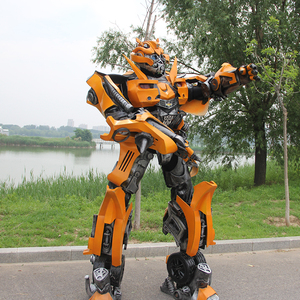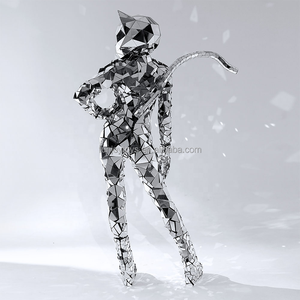(21306 products available)







































































































































































































Robot LED lights are used to communicate and express messages. The following are the common types of robot LED lights available on the market today.
Single Color LED Light
These are the most common types of light-emitting diode lights that emit a single color. They are available in different colors like red, blue, yellow, and green. These lights are used for basic communication and signaling. For instance, a red LED light can be used to signal stop, while a green light can signal go. Single-color LED lights are preferred for their simplicity and efficiency. They have low power consumption and high visibility, making them ideal for various applications. They are commonly used in robotics for basic signaling and communication tasks. They are also used in other fields like traffic lights, indicators, and simple displays.
Multi-Color LED Light
These are advanced light-emitting diode lights capable of changing colors. They can produce different colors by mixing the primary colors of light, red, green, and blue (RGB). These lights are used for more complex communication and expression. For instance, they can be used to mimic facial expressions in robot heads. Multi-color LED lights are versatile and can be programmed to produce a wide range of colors. They are used in robotics to create more dynamic and expressive communication. For example, they can be used to indicate the robot's status or mood. They are also used in other applications like stage lighting, decorative lighting, and advanced displays.
White LED Light
These are another type of robot LED light that emits white light. They are used for illumination and visibility. White LED lights are preferred in applications where clear and bright light is needed. For instance, they can be used to light up a robot's working area or to illuminate a robot's path. White LED lights have high efficiency and long lifespan, making them suitable for continuous use. They are used in robotics for general lighting purposes. They are also used in other fields like automotive lighting, indoor lighting, and outdoor lighting.
Programmable LED Light
These are robot LED lights that can be programmed to change their color and pattern. They are used for complex communication and signaling. For instance, they can be used to create dynamic light patterns to indicate different states or actions of a robot. Programmable LED lights are versatile and can be customized to suit specific applications. They are used in robotics to create more sophisticated and interactive communication. For example, they can be used to create light patterns that respond to the robot's environment or user input. They are also used in other applications like interactive displays, games, and educational tools.
Most of the LED designs are flexible and can be molded to suit the requirements of the client. Below are some of the key design features of the robot LED lights.
Modular design
Modular designs allow for easy customization and scalability of the robot LED lights. Modular designs enable the creation of LED panels with light strips, cubelets, and modular LED lights that can easily be rearranged to develop new designs. Modular designs also allow for easy repairs and replacements of the components of the LED lights. Modular design improves the flexibility and versatility of the robot LED lights.
Flexible and bendable LED lights
Flexible and bendable LED lights easily conform to the complex shapes of the robot's body. The lights easily fit into small and irregular spaces. Flexible and bendable LED lights improve the uniform lighting of the robot by providing lighting in areas that are difficult to reach. The lights are also lightweight, which reduces the overall weight of the robot. The flexibility and bendability of the LED lights allow for easy installation and replacement.
High-density LED arrays
High-density LED arrays provide bright and uniform illumination. The LED lights consume low power, which extends the robot's operational time. The lights are also small and compact, which allows the robot to have a small form factor. The high-density LED arrays are reliable and have a long lifespan. They are also easy to control and can be easily programmed to produce different lighting effects. The high-density LED arrays are used in applications such as robotics, automotive lighting, and architectural lighting.
Smart LED lights
Smart LED lights use sensors to detect the environment. The lights adapt the brightness and color to the surrounding environment. Smart LED lights are connected to the network and can be controlled remotely. The lights can also communicate with other devices and systems. Smart LED lights improve the efficiency and effectiveness of the lighting system. They are used in applications such as smart homes, smart cities, and connected vehicles.
Transparent and translucent materials
Transparent and translucent materials enhance the aesthetic appeal of the robot LED lights. The materials also protect the LED lights from environmental factors such as dust and moisture. They improve the diffusion of light, which reduces the harshness of the light. Transparent and translucent materials are lightweight and durable. They are used in applications such as automotive lighting, architectural lighting, and decorative lighting.
When dressing up or incorporating robot LED lights into various settings, consider the following ideas to create a cohesive and visually appealing look:
Matching suggestions
When matching suggestions, consider complementing colors and themes. For instance, pair bright and neon LED Robot toys with dark or metallic finishes to create a sleek, modern look. Conversely, match pastel-colored LED robots with softer, more organic shapes to evoke a friendly, approachable vibe. Additionally, consider the environment where the LED robots will be placed. For instance, outdoor spaces may benefit from weather-resistant robots with brighter, more vibrant LED lights to stand out against natural backdrops. In contrast, indoor settings may allow for more delicate and intricate designs that blend seamlessly with existing decor. Remember to balance between contrasting and complementary elements to achieve a harmonious overall design.
Wearing suggestions
To integrate LED robots into an outfit, start by selecting a theme. Futuristic attire could include metallic fabrics and sleek lines, perfect for incorporating LED robots as accessories. Choose robots with bright, flashing LEDs to complement the modern look. For a casual, playful style, opt for LED robots that resemble toys or cartoon characters. Integrate them into one's clothing through LED-embedded shirts or hats, adding a touch of whimsy to a relaxed ensemble. Additionally, consider the color scheme. Matching the colors of one's clothing with the LEDs' hues creates a cohesive appearance. Alternatively, contrasting colors make the LED robots stand out, creating a bold statement.
Q1: What are the advantages of using LED lights on a robot?
A1: LED lights provide several benefits for robots, including enhanced visibility, energy efficiency, and long lifespan. They can be used for signaling, communication, and illumination, improving a robot's functionality and safety in various environments.
Q2: Can robot LED lights change color?
A2: Yes, some robot LED lights can change color. This capability is typically achieved using RGB LEDs, which can mix red, green, and blue light to produce various colors. These lights can be controlled programmatically to change color based on the robot's status or environment.
Q3: How are LEDs controlled in a LED robotic arm?
A3: LED lights in a robotic arm are controlled using microcontrollers or microprocessors. These controllers send signals to the LED drivers or directly to the LEDs to turn them on, off, or change their brightness and color. The control can be done in real time based on the robot's sensors and feedback system.
Q4: Are LED lights in robots durable?
A4: Yes, LED lights are generally durable and well-suited for use in robots. They are solid-state devices, which makes them more robust and less prone to damage than traditional incandescent or fluorescent lights. Additionally, LED lights are resistant to shock and vibration, making them ideal for mobile and industrial robots.